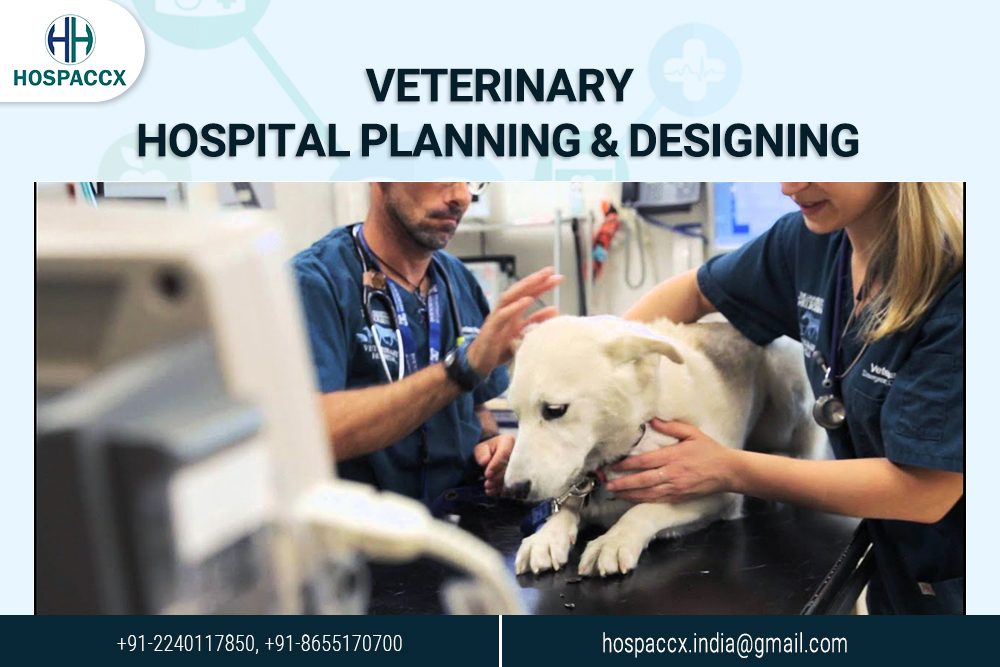
Introduction
A ‘Veterinary Hospital’ or ‘Animal Hospital’ is defined as a place used to diagnose animal diseases or disorders, surgically or medically treat animals, prevent animal disorders etc. Treatment may include keeping the animals on the premises for treatment.
Considering the above facts, Hospaccx team participates in ‘Planning and Designing of Veterinary Clinic. This is macroficial study of veterinary clinic planning and designing if you want to get into more detail you can contact hospaccxconsulting.com
Departments
The following is a list of the rooms and facilities usually required in a Veterinary Hospital:
Reception room
- The reception room is planned to seat four to five people and their animals per veterinarian. This number will decrease per veterinarian as the number of veterinarians increases.
- It is extremely important that in the original planning this room not be made too small, for in the case of future expansion, this space, with additional furniture, should be adequate to accommodate the additional patients.
- Many animal hospitals use a system of stalls in the waiting room. This stall is usually 2′-6″ wide and 4′-0 ” deep, in which the owner and the animal sit and wait until called by the veterinarian.
Business office
- The business office should be accessible to separate entrances from the reception room and the hospital in general. It may well adjoin the staff room.
- In the business office should be kept the inactive records. Space in the business office or the staff room should be available for staff members to use while completing medical records.
Private office
- This room is a small space where the veterinarian can carry on private conversation, study and relaxation.
- The office should be isolated from the clients, but readily accessible to the business office and the examination room.
- The veterinarian should be able to reach this room by a secondary entrance in the building and not be forced to walk through the reception room.
Examination room
- The examination room is an area where veterinarian and client can discuss and examine the patient, as well as treat minor ailments. 90 to 120 sq. ft. of floor area are usually adequate for this room.
- Efficient operation requires that 1-1/2 examination rooms per veterinarian should be provided. This room should contain an examination table, supply cabinet, and sink; it may also contain chairs for the client and a writing desk for the veterinarian.
- The examination room should be made as quiet as possible to facilitate examinations. It should be easily darkened so that the eyes may be examined.
Work room – laundry
- The work room is usually provided in large hospitals.
- It is used for dressing wounds, taking fecal, blood, or urine samples, and other miscellaneous tasks.
Preparation Room
- The preparation room is used to prepare the animal for surgery.
- This room is also used for setting broken legs and applying splints, both wooden and metal. Therefore, it should be equipped with a small band-saw vise and a work bench on which both wood and metal may be worked.
- It should be adjacent to the surgical ward, recovery ward and X-ray room.
- The wall between the preparation room and the recovery ward should be of clear glass so that the person working in the preparation room can watch the dogs in the recovery room in case they regurgitate.
- The wall between the surgery and the preparation room should be equipped with a clear glass panel also so that the veterinarian can supervise the work going on in the preparation room from the surgery.
Surgery Room
- The surgery should be adequate to accommodate major operations.
- The surgery room should be air-conditioned, and if separate units are used, temperature and humidity should be the same as that in the preparation room and recovery ward.
- Adjacent to the surgery should be a scrub-up room where those concerned with the surgery may cleanse themselves properly.
Dark Room & X-Ray Room
- In a small hospital, X-ray equipment may be small and may be placed in a room which is not used to a great extent. However, in a large hospital a separate room is necessary.
- The X-ray room should be so located to be readily accessible to the in-patient areas and as close as possible to the preparation room and surgery.
Scrub-up Room
- The scrub-up room should contain two scrub-up sinks equipped with knee operating faucets and disinfectant material nearby, operated by either foot, knee or elbow.
- Also, there should be a place where sterile brushes may be stored adjacent to the sinks.
- There should be a small window between the scrub-up room and the operating room. This is desirable for the veterinarian to observe what takes place in the operating room while he scrubs.
Laboratory & Pharmacy
- The space allotted for the laboratory work depends upon the size of the hospital and the amount of actual laboratory work that the veterinarian plans to do. Many hospitals combine this room with the pharmacy, and sometimes it is also the work room.
- From this room much of the basic information on the patients’ health and well-being is brought forth. Therefore, it should be well planned and well equipped.
- The pharmacy should be convenient to the examination rooms and the main hospital area. Space will be required for a small refrigerator and a safe if narcotics are to be used. The pharmacy should be placed in the care of a responsible person so that sufficient drugs and stocks are kept on hand.
Wards
- The recent trend in wards has been that the wards be kept small. A ward of ten to twelve animals is considered ideal.
- In a small ward the animals are less likely to be disturbed and there is less contact between patients.
- Much of the noise can be eliminated if the cages are arranged so that the animals cannot see one another.
- It is recommended that a space of at least 41-6″ to 5′-O” remain in front of the cage for access.
The exact number of wards in a hospital can fluctuate greatly. Two general wards and an isolation ward compromise a minimum. Some hospitals have included all of the following:
- Recovery ward
- Medicinal ward
- Surgical ward
- Skin ward
- Isolation ward
- Cat ward
Exercise Runs
Adjacent to all wards a place should be provided where the dogs may be allowed to exercise. In the isolation ward where the animals are confined, an area should be provided for their exercise.
Grooming & Bathing Room
- The size of this room will fluctuate considerably in accordance with the veterinarian’s attitude toward this phase of practice.
- This room should be adapted into the plan in such a manner that the animals using this service must not use the reception room. The animals could be taken to this room and placed in a cage and left.
Cages
- There is no one answer as far as the ideal cage is concerned. There are as many cage designs as there are veterinarians.
- The materials used for the cage construction should be easily maintained, tough, hard surface, and scratch resistant.
Conclusion
To conclude, Specific area must be provided to different departments of veterinary hospital. Day to day functioning of veterinary hospital becomes easier due to appropriate planning & designing of hospital.
It is the superficial and macro level study for more details kindly contact Hospaccx Healthcare business consulting Pvt. ltd on hospaccx.india@gmail.com















